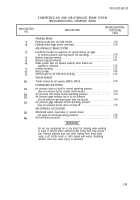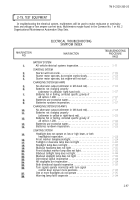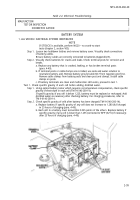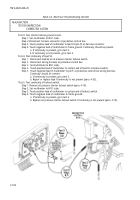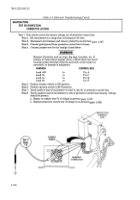TM-9-2320-260-20 - Page 186 of 1337
TM 9-2320-260-20
Table 2-4. Electrical Troubleshooting.
MALFUNCTION
TEST OR INSPECTION
CORRECTIVE ACTION
I
1. ALL VEHICLE
Step 1.
Step 2.
BATTERY SYSTEM
ELECTRICAL SYSTEMS INOPERATIVE
NOTE
If STE/ICE is available, perform NG20 – no crank-no start
tests (chapter 2, section VII).
Loosen two holddown latches and remove battery cover. Visually check connections
of battery cables.
Ensure battery cables are correctly connected to batteries (Appendix E).
Visually check batteries for cracks and leaks. Check terminal posts for corrosion and
breaks.
a. Replace any battery that is cracked, leaking, or has broken terminal posts
(para. 4-49).
b. If terminal posts or cable clamps are corroded, use soda and water solution to
neutralize battery acid. Remove battery ground cable 68-7 from negative post first.
Remove cable clamps from battery posts and clean post and clamps. Install cable
clamps on posts.
c. If battery terminals are clean and malfunction still exists, proceed to test 1.
Test 1. Check specific gravity of each cell before adding distilled water.
Step 1.
Step
2.
Using optical battery tester which requires no temperature compensation, check specific
gravity of electrolyte in each cell (TM 9-6140-200-14).
If specific gravity of any cell is below 1.225, battery must be replaced or recharged. Add
distilled water as necessary after checking battery. For charging procedures, refer to
TM 9-6140-200-14.
Check specific gravity of cells after battery has been charged (TM 9-6140-200-14).
a. Replace battery if specific gravity of any cell does not increase to 1.280 (full charge)
in 25 hours of charging (para. 4-49).
b. Each cell in a battery must test within 0.025 points of the others. Replace battery if
specific gravity of any cell is lower than 1.255 (corrected to 90°F (32°C) if necessary)
after 25 hours of charging (para. 4-49).
2-99
Back to Top

